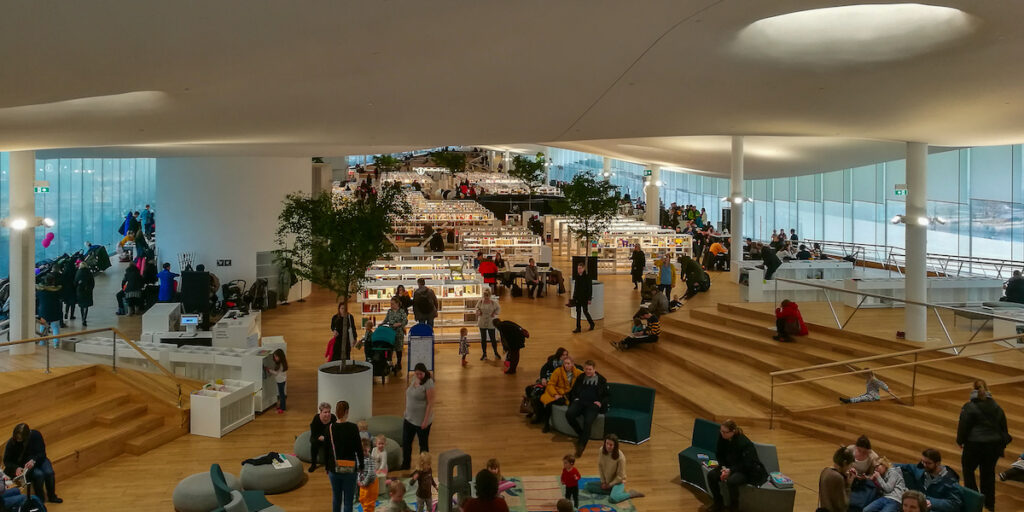Edoardo Montenegro shares his impressions back from Helsinki, where we completed xEdu’s acceleration program.
Betwyll’s acceleration with xEdu allowed me not only to visit some libraries in the cities of Espoo and Helsinki, but also to talk extensively with librarians and public servants engaged in designing local library systems, in the effort to better understand the role of libraries within the Finnish culture.
I have a very limited knowledge about what a library is and how it works. I’m not a librarian, I didn’t studied library sciences and, though dealing with the promotion of reading, I consider myself just a library user. I will therefore write my travel notes as a reader, dreaming of If on a winter’s night a traveler and The Name of the Rose.
The libraries: digital, widespread, inclusive
To start with, what surprised me in Finland was the integration between the physical and the digital services provided by libraries. All the people I talked to, regardless of their job or organizational context, suggested to visit Helmet, the digital portal of the city libraries of Espoo, Helsinki and Vantaa.
And it’s precisely by exploring Helmet that a second element stands out, namely the diffusion and the extensiveness of the public library system. The three cities, with about 1.150.000 inhabitants overall, have 68 different libraries, i.e. one every 17.000 inhabitants. In addition, many of these are located next to railway and bus stations, surrounded by shopping centers and shops. Libraries, therefore, are never isolated: they are placed where people meet.
The third element worth highlighting is precisely their public dimension. Libraries are the most appreciated service by the citizens of Helsinki, preceded only by tap water. And they are also a concrete tool of immigration policies: as soon as an asylum seeker is acknowledged the right to stay in the country, in fact, he gets a library card so as to immediately access services favouring cultural integration.
After visiting many libraries in Italy, often frequented mainly by students who use them as study halls, compensating for the lack of university facilities, it is surprising to see the same places busy with new citizens and migrants – whether kids playing video games, teenagers finding books and services in their own mother language or adults attending courses to learn Finnish.
This dimension reflects an underlying project design. In the city of Espoo, for example, not only all the library services are free, as provided for by law, but the software used has Finnish, Swedish, English and Russian interfaces. Besides, specific services in Estonian, Arab, Somali, Chinese and Dari – a version of the Persian language spoken in Afghanistan – are developed ad hoc for refugees and migrants.
Two examples: Oodi and Sello libraries
It is difficult to talk of libraries in Finland without mentioning Oodi, Helsinki’s new city library, inaugurated in December 2018 and designed by the Finnish studio ALA Architects. To an external visitor, this building appears in fact as the actual cultural and civic hub of the Finnish capital. Next to the main railway station, it dominates an area overlooking the sea and already hosting the Amos Rex Museum of Modern and Contemporary Art, the Kunsthalle, the Helsinki Music Center, the Finland Hall and the National Museum of Finland, just as a spaceship landed from outer space.
The truly distinctive feature of Oodi is the dismantling of the rhetoric of reading. Books aren’t small monoliths closed in cases to awe readers, but the conclusion of an experiential journey focused on the citizen as a reader and a culture maker himself. Books are on the third floor, whereas the first floor hosts mainly reception services and on the intermediate floor visitors can test innovative tools – from laser cutters to 3D printers, from modern serigraphy and sewing techniques to virtual reality games – and freely use ad hoc rooms and spaces based on their needs.
However, it was only when I visited Sello Library in Espoo, and discussed with a group of librarians working there for kids and teenagers, that I understood the value of the Finnish library services and why Espoo’s city libraries were awarded as the best in the world at London Book Fair in 2019.
Participatory planning is the key
A foreign public administrator, visiting Finland and willing to copy its exterior aspects only – as it often unfortunately happens – would fail. It’s not the design, the quality of the materials and the sophistication of the tools available to the citizens that make the difference. What makes the Finnish libraries unique is a participatory planning method that actually listens to the citizens and, thanks to the professionalism of expert and motivated public servants, implements effective and sustainable services and solutions.
At this point of the story, some may wonder whether Finnish libraries aren’t too expensive. Actually, on further reflection, the key aspect is exactly this one: the priorities of the political agenda. The new Finnish Prime Minister, Antti Rinne, after winning the elections, chose Odii as the place where to introduce his coalition and, once taken office, he started a tour of the country’s libraries, continuing until September, to present his government programme.
I won’t delude myself into imagining that something similar will ever happen in Italy, even if I know that despite everything in our country, too, there are excellent – though increasingly poorer – library systems. Nevertheless, I understood that what we just dream and consider impossible actually exists, and is feasible. Democracy and the future are not made through books only, but are built in libraries, as well.
Edoardo
[email protected]


